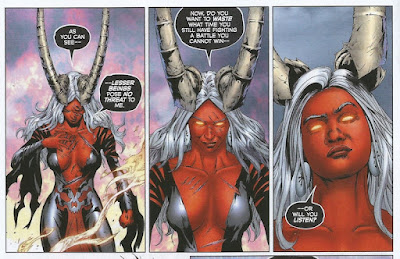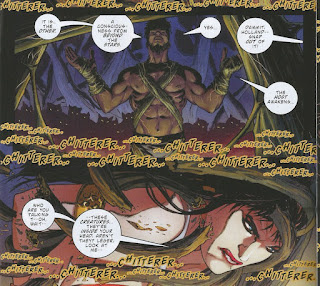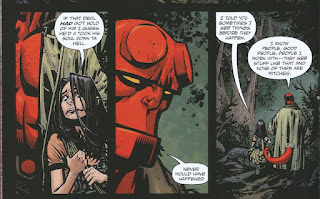Pick of the Brown Bag
February 19, 2020
Part Three
by
Ray Tate
In the third and final part of the mid-February edition of the POBB, I examine Hellboy and the BPRD, Omni, Red Sonja and the Age of Chaos and Vampirella. These have already been tweeted. So, if you're in a rush, head on over to Twitter: #PickoftheBrownBag.
Red Sonja finally destroyed her arch-nemesis Khulan Gath. Of course, as Marvel Team-Up relates, any weak-willed individual possessing Gath's necklace will serve as Gath's resurrection host. Sonja knows Gath's shtick by heart. So she made certain the necklace wouldn't fall into the wrong hands. She weighted it down and dumped it in the middle of the sea. Alas.
So speaks the explicitly described but unimaginatively named Lady Demon.
A Chaos Comics representative, Lady Demon's design is overall striking. That said. This is probably the most she's been clothed. Anatomist Jonathan Lau and colorist Andrew Dalhouse take something meant to only titillate and transform it into something more organic, realistic and practical.
Lady Demon is not the hero like Sonja or Chastity the half-vampire with a mohawk. She's in this for spite and oneupmanship.
Red Sonja and the Age of Chaos continues to be surprisingly good. Burnham explains the motivations of less familiar characters without heavy exposition and the art does the rest. For example...
...I don't know the figure, and she's unnamed in the book. Lau's and Dalhouse's art identifies her as a good guy. This is further confirmed by the silver bullets comment.
The African-American model on the cover of Vampirella is the real deal in celebration of Black History Month. For that Dynamite can be commended. She's actually posing as Vampirella and not Victory, Vampirella's ex who has taken to wearing V's costume, albeit sable.
The first page in Vampirella also celebrates Black History Month with an abbreviated tour of the subject. However, it's gimmicky because this lesson doesn't actually pertain to anything.
On the other hand, there are more black roles amongst the cast than usual. Such integration is always a good thing, but this issue of Vampirella isn't entirely successful in conveying such importance.
Half of Christopher Priest's story consists of Vampirella contending with an empowered human who believes himself to be the protector of a mind parasite.
Vee gets through to him via reason and sex, which sums up the character nicely.
What is Vampirella if not a rational explanation for vampirism. An immortal shape-shifting alien from the planet Drakulon created by Forrest Ackerman and Tom Sutton, who rocks a costume that ignites lurid thoughts, designed by the legendary illustrator and historian Trina Robbins.
That half of the book is solid B Grade Vampirella that includes a nice, visual explanation of why Vampirella teaches children as Ella Normandy.
Unfortunately, Priest’s Neil Gaiman inspired witch boy Benny finds himself in the pickle of a Grade Z flick that stereotypes African-Americans as superstitious voodoo-loving loonies. This is not the infamously terrifying episode of Kolchak “Zombie.” It’s there for cruel laughs and that makes the Bokor even worse.
Omni caught my attention this week. I’ve been reading Omni since the beginning, but it’s not what I would call one of my A-List books. I like Devin Grayson’s writing, but there was usually something missing in Omni. In fact I was considering cutting it loose, but this issue is the save.
Omni is the story of Dr. Cecilia Cobbina who is the earth’s Sherlock Holmes. She travels with her assistant Mae in an RV, searching for other empowered individuals like herself while vying against the world’s problems. She’s being funded by a shadowy group called Omni that’s insinuated themselves in her search and her life. They claim to be UNCLE, but they very well could be THRUSH.
Writer Melody Cooper takes over the writing, and the change is evident in elegantly orchestrated dialogue that’s matched by art from Giovanni Valletta and Bryan Valenza.
The plot for this issue is also a step up, with a greater attention to feminism. The story centers on mercy, provided to unfortunates caught in the desert.
These are the water witches. Cooper’s tale swirls around the issue of clean water, how it’s vital for life, but is as of yet not listed or accepted as a basic human right.
Cooper fuses this tale with the idea commonalities for all humans. Particularly women. Cooper takes one of the grand dames of exploitation and turns it into a positive origin story.
The quiet of the story is actually its greatest asset. We get an example of Cecilia using her abilities but as well we get an engrossing tale about kindness amidst a volatile world that sets up a strong cliffhanger.
Hellboy and the BPRD has been very hit and miss since Hellboy’s death. I’ve come to the conclusion that Mike Mignola took the direction Hellboy had to go, based on what was best for the story, but it was an ultimate end. I sometimes wonder what would have happened at the crossroads had Mignola chosen the opposite direction and revealed that Hellboy was in fact the son of Arthur Pendragon.
For the conclusive reason, Mignola’s gone back in time to fill in the blanks. That’s the only thing that’s left. The trouble is that he keeps trying to find more interesting characters than Hellboy, and that’s just not possible. All the characters Mike Mignola created thus far are mildly interesting, but nothing compares to Hellboy. In fact his second most interesting figures such as Liz Sherman are still part of the Hellboy universe.
Few of these set-in-the-past stories do anything but go through the motions. “The Return of Effie Kolb,” is the most I’ve enjoyed Hellboy in a long time. That may be because it's a sequel to Hellboy and the Crooked Man.
Hellboy visits an old friend, who lays out the plot from long ago. Everything looks great thanks to Zack Howard and Dave Baron. Mignola now introduces another new character.
This one though takes. Sara May becomes Hellboy’s companion in a new fight against the supernatural that involves his old enemies.
There’s enough time in the tale to establish mood and Hellboy’s personality. For example, he expresses his utter disdain for intolerance and superstition.
Hellboy and Sara May travel to a dilapidated mansion where they meet a classy new potential threat straight out of 1970s horror.
Who is Miss Brook? Is she legitimate? A vampire. A different sort of creature, or maybe she’s just as she says.
To quote Hellboy:





















No comments:
Post a Comment